Target Audience
This document is a support tool for non-professional audience including Florida homeowners and plant enthusiasts aiming to effectively manage weed encroachment into turfgrass areas. However, this document may be also utilized by turfgrass professionals, including but not limited to sod producers, golf course superintendents, athletic and sports fields managers, landscape managers, and extension specialists.
Introduction
Weeds can be defined as unwanted plants or plants growing out of place. As such, they interfere with or disrupt human activities and are associated with managed environments (Figure 1) including perennial turfgrass settings. Their presence in such areas is inevitable and causes a significant, multi-level problem. Weeds compete with desirable turfgrass for resources such as sunlight, water, nutrients, and space. Moreover, they harbor insects and pathogens, which attack desirable plants. Primarily though weeds compromise the functions of turfgrass surfaces. The impacts of weeds, however, extend to a broader spectrum of complex economic and health issues. Economic impacts consist of two components: 1) losses resulting from the reduction in outputs of an enterprise (production, quality, playability, efficiency, functionality, value, etc.) and 2) costs representing investments made to manage or control weeds (e.g., labor, machinery, time, pesticides). Health impacts on both humans and animals include threats caused directly by certain plants (e.g., allergies, dermatitis, poisoning, wounds due to spikes, thorns, etc.), as well as risk for injuries resulting from the presence (or absence e.g., due to rapid removal) of weeds in certain turfgrass settings [e.g., reduced turfgrass tensile strength due to competition, uneven playing surfaces (i.e., clumps or voids in sward in athletic turf scenarios), fire threat due to weed encroachment or limited driving visibility due to tall plants in highway rights-of-way, bites or stings by insects associated with weeds occurring within turf canopy, etc.]. Therefore, the establishment of reasonable tolerance thresholds followed by employment and integration of various control measures aimed at the reduction of infestation levels to acceptable is a necessity. Although weeds are typically viewed as unsightly, unless they substantially negatively impact aspect related to turf's utility, other primary functions, or economics (e.g., property market value), from the environmental standpoint, aesthetics should not be a driving factor in management-related decision-making process.
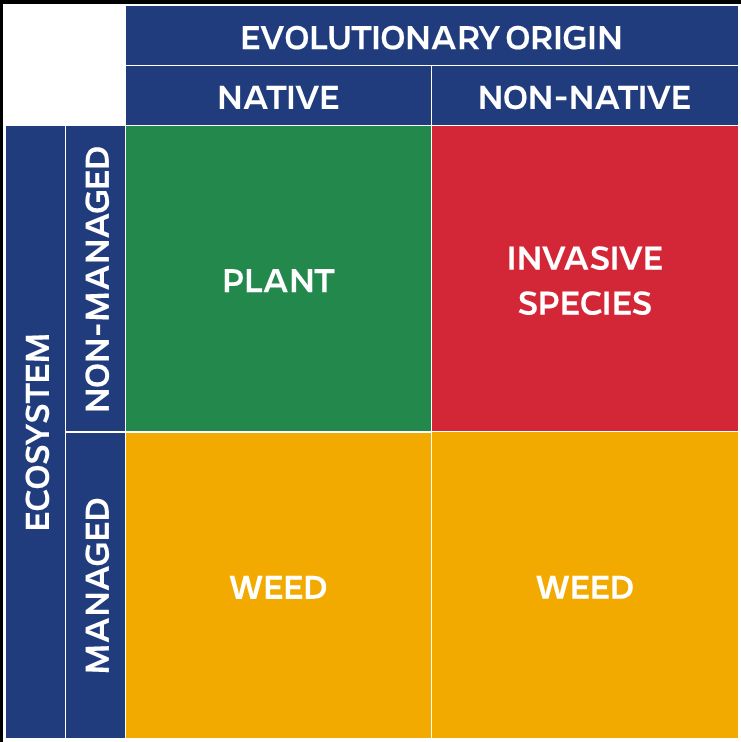
Credit: UF/IFAS
Importance of Proper Weed Identification
Proper weed identification should serve as the initial step in the decision-making process related to weed management. Knowledge of an actual weed species allows for insights into its environmental preferences. Armed with this knowledge, efforts can be made to effectively identify and address the underlying causes of infestation. Furthermore, accurate identification provides an understanding of the weed's growth and reproductive characteristics, thus revealing both its strengths and weaknesses. These insights should be leveraged when selecting the most appropriate control measures. Additionally, knowing whether weeds were previously present in an area assists in preparation of additional preventive strategies. Effective weed control necessitates a coordinated program carefully planned around weed biology which determines specific management methods and optimal implementation timing. If only possible, identification of an actual species is crucial, as significant differences may exist between certain species within the same genus, necessitating different approaches.
Weed Types
Weeds may be classified in a variety of different ways. Such categorization is achieved by grouping together those species, whose similarities are greater than their differences. Most common classifications used for the purposes of weed management in turfgrass scenarios are by morphology (i.e., monocots and dicots); structure and form (i.e., broadleaves, grasses, sedges/rushes); and life cycle considered as period between seed germination and plant death (i.e., annuals, biennials, and perennials).
Monocots
Monocots (Figure 2), or monocotyledonous plants have only one cotyledon, or seed leaf, present when seedlings emerge from the soil. This group encompasses mainly grasses, sedges, rushes, but also some individual species that are generally considered as broadleaves (e.g., doveweed).
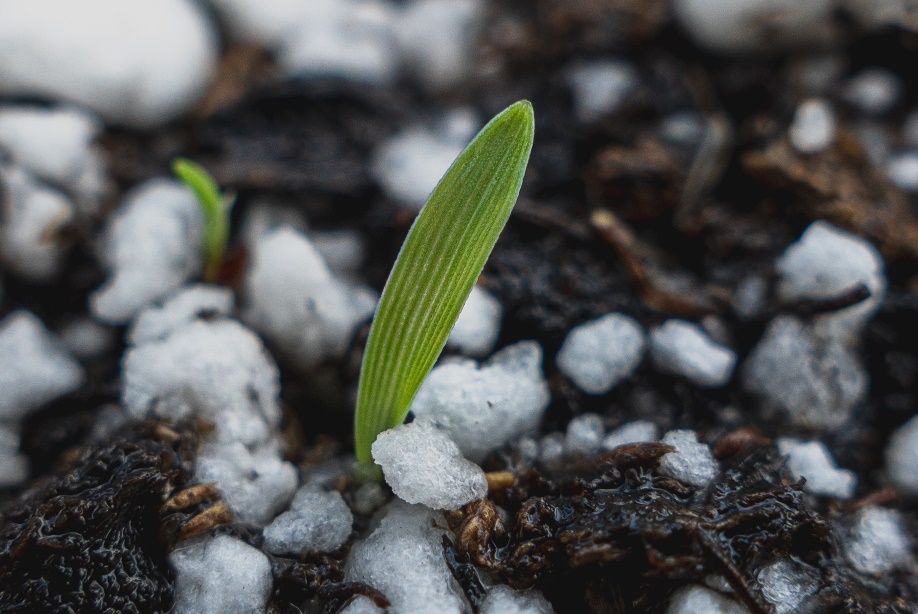
Credit: Pawel Petelewicz, UF/IFAS Department of Agronomy
Dicots
Dicots (Figure 3), or dicotyledonous plants, have two cotyledons (seed leaves) when the weed seed germinates. This group consists mainly of broadleaf plants.
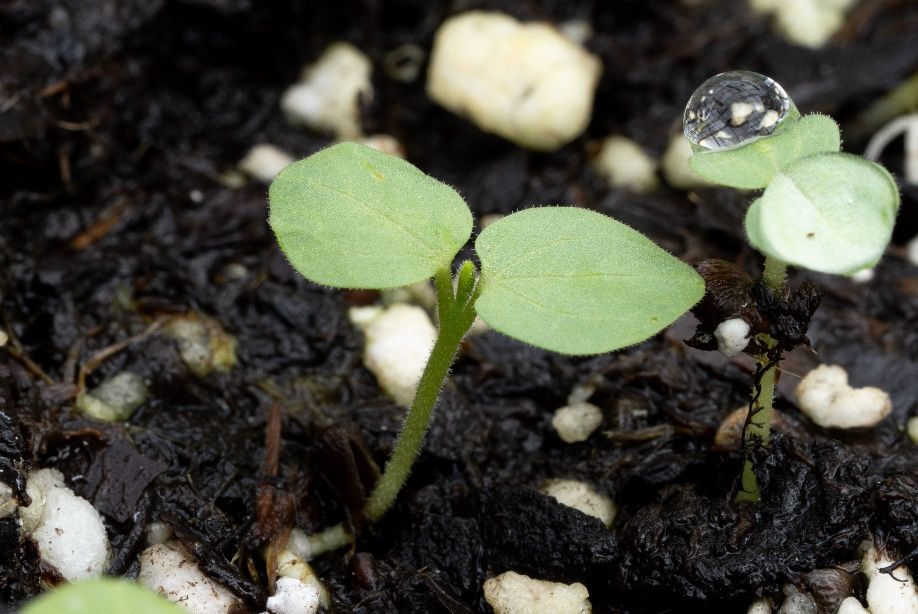
Credit: Pawel Petelewicz, UF/IFAS Department of Agronomy
Broadleaves
Broadleaves (Figure 4), as name indicates, usually have broader foliage of various shapes. Their true leaves have net-like veins and usually they have showy flowers. Examples include spotted spurge, clovers, lespedeza, plantain, henbit, chickweed, Florida pusley, beggarweed, and matchweed.
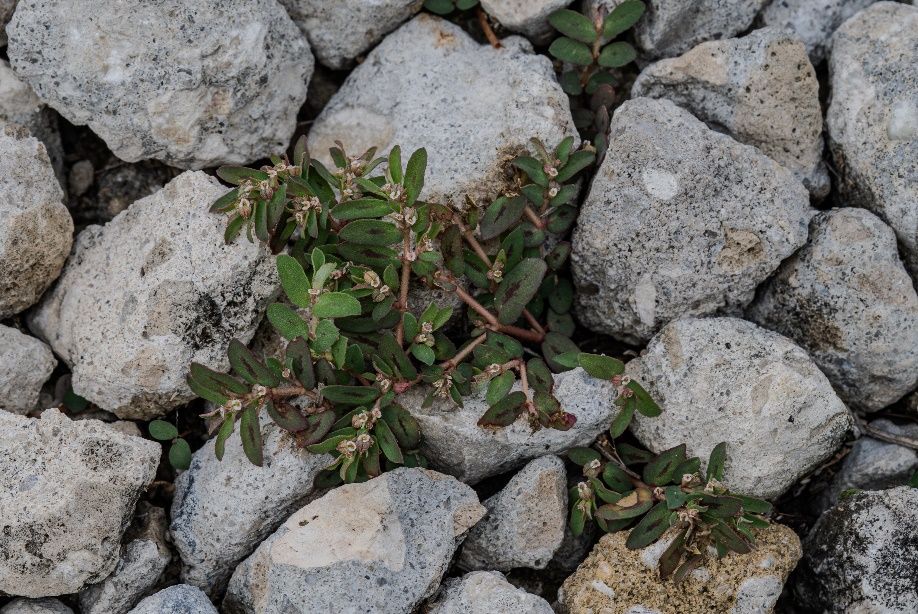
Credit: Pawel Petelewicz, UF/IFAS Department of Agronomy
Grasses
Grasses (Figure 5) have hollow, rounded stems with nodes (joints) and parallel veins in their true leaves. Examples include crabgrasses, goosegrass, crowfootgrass, bullgrass, annual bluegrass, tropical signalgrass, cogongrass, torpedograss, smutgrass, and dallisgrass.

Credit: Pawel Petelewicz, UF/IFAS Department of Agronomy
Sedges/Rushes
Sedges (Figure 6) as a group can be quite easily distinguished from others as they have triangular-shaped, solid stems which can be simply identified by rolling such stem between fingers. The stems of rushes are round but also solid (as opposed to hollow in grasses). Both sedges and rushes favor a moist habitat. Among those plants, nutsedges; which have the ability to produce underground structures called tubers or nutlets; are especially troublesome. Economically important members include yellow and purple nutsedge and, to some degree, globe, Texas, annual, and water sedge, beak rush and kyllingas.
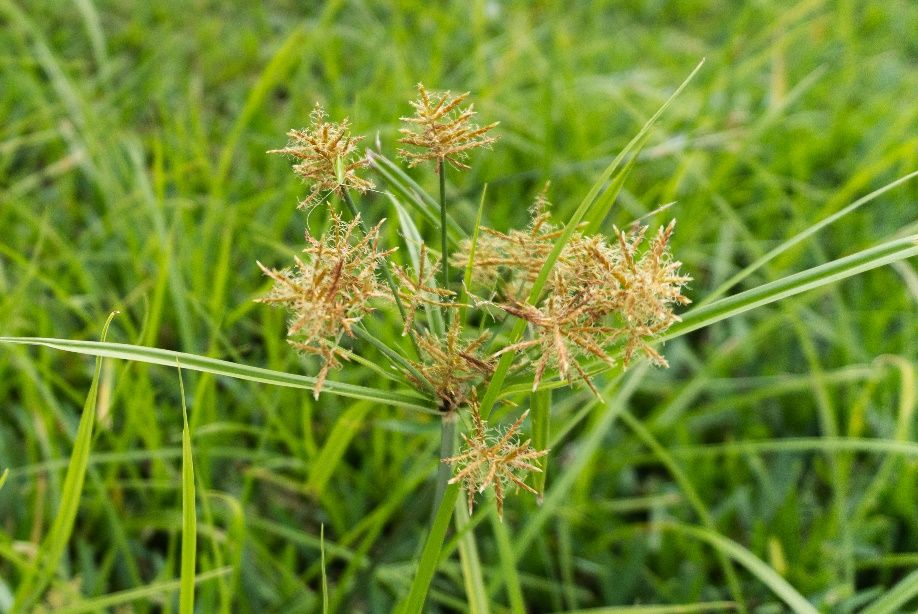
Credit: Pawel Petelewicz, UF/IFAS Department of Agronomy
Annuals
Annual weeds complete their life cycles in one growing season. Summer annuals complete their life cycles from spring to fall. Winter annuals complete their life cycles from fall to spring. Summer annual grasses, as a group, are generally the most troublesome weeds in turf.
Biennials
Weeds that complete their life cycles in two growing seasons are called biennials. Most biennial plants show only vegetative growth during the first growing season, and flowering occurs during the second growing season. There are no true grassy biennial species.
Perennials
Weeds that require three or more years to complete their life cycles are considered perennials.
Weed Prevention Methods
St. Augustinegrass is the most commonly used lawn grass in Florida. It is followed by zoysiagrasses across the state or by centipedegrass in Florida Panhandle. Bermudagrass is the most commonly managed turfgrass in Florida athletic fields and golf courses. Lastly, bahiagrass is often utilized in Florida as a go-to low-maintenance lawn species. Therefore, this publication focuses on management options appropriate for the aforementioned turfgrass types in Florida.
Regardless the turf species, the effective management of weeds necessitates an integrated, systematic approach, wherein success may be dependent on multiple years of patient execution of carefully planned strategy aimed to reduce the seed bank or surviving structures to the acceptable levels.
Proper Management and Cultural Practices
The presence of weeds is a result of a weakened turfgrass stand, not the cause of it (Figures 7 and 8). It is the lack of proper turf density, occurrence of voids in sward and any open areas that allow light to the soil surface that are promoting weed encroachment. Therefore, unless the factors contributing to the turf underperformance are corrected, continued weed encroachment should be expected. In other words, successful weed control starts with the high quality, healthy and dense, thriving turf which is achieved through proper management practices. Healthy turf shades the soil so sunlight can't reach weed seeds ready to germinate. A thick turf also minimizes the physical space available for weeds to become established. This is the most important and in fact—least recognized—mean of preventing weed establishment. Optimizing management practices to meet the environmental requirements of turfgrass and promote its competitiveness is a key to effective weed prevention and helps reduce the cost of weed control while maintaining the quality lawn surface.
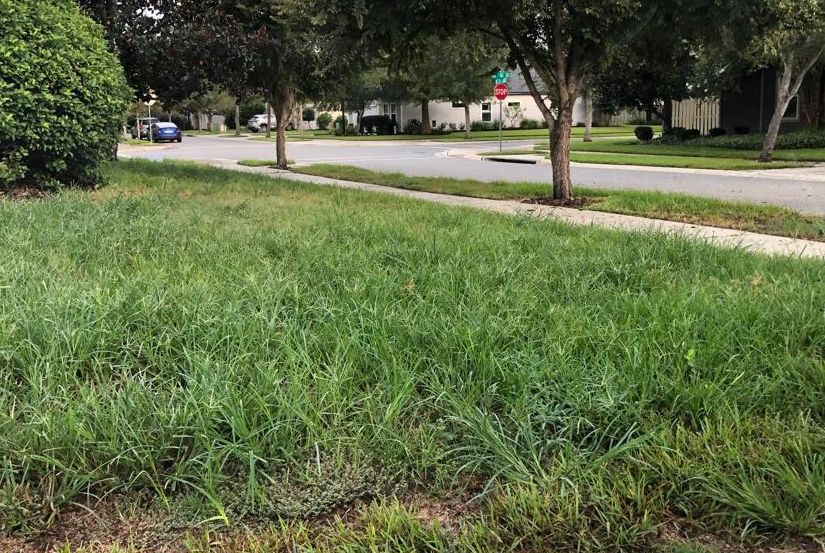
Credit: Pawel Petelewicz, UF/IFAS Department of Agronomy
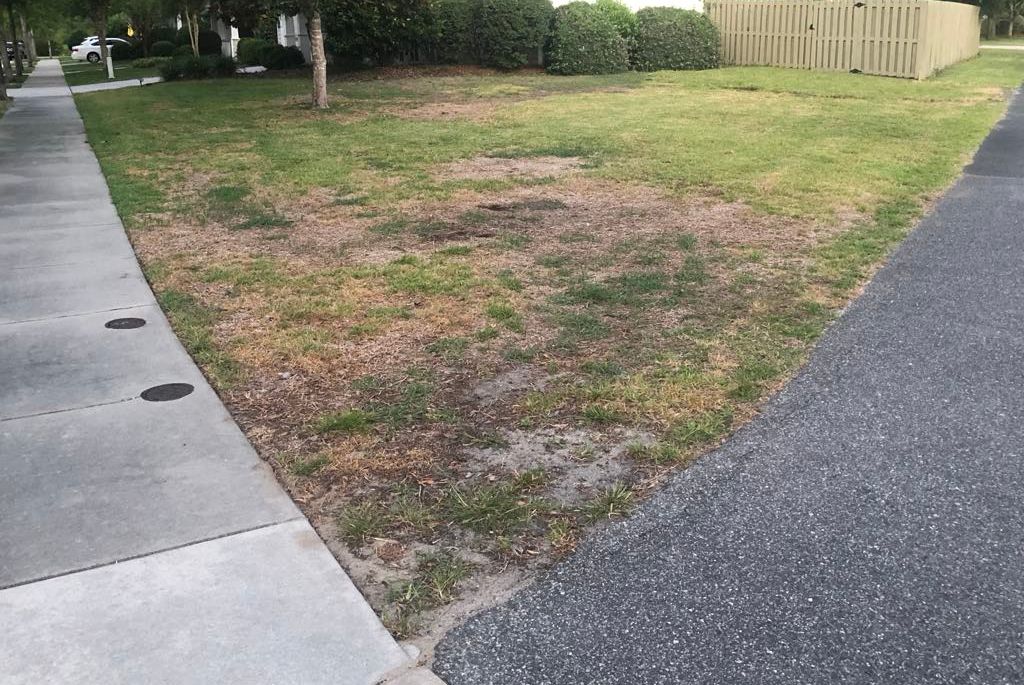
Credit: Pawel Petelewicz, UF/IFAS Department of Agronomy
Proper fertilization, watering, and mowing are required to produce a dense turf that can prevent weed infestation. If turf is over- or underwatered, over- or underfertilized, or mowed too low or too infrequently, the turf is weakened, and weeds move in. Sharpening the mower blades can reduce turf damage and the chances for weed invasion. Turf damaged by foot or vehicle traffic invites weeds. Turf growing in soil compacted by excessive traffic, especially when the soil is saturated with water, cannot develop a healthy root system as well as it can under noncompacted soil conditions. Goosegrass, annual bluegrass, dollarweed, and certain sedges grow well in compacted and/or continuously wet soil. To manage weeds in such a situation, the methods for soil compaction alleviation and/or saturated condition should be considered. It is very important to understand that weeds don't create a void; they fill a void.
For additional resources on proper turfgrass management practices consult Homeowner Best Management Practices for the Home Lawn (https://edis.ifas.ufl.edu/EP236), Mowing Your Florida Lawn ((https://edis.ifas.ufl.edu/LH028), Watering Your Florida Lawn (https://edis.ifas.ufl.edu/LH025), Fertilization and Irrigation Needs for Florida Lawns and Landscapes (https://edis.ifas.ufl.edu/EP110), Urban Turf Fertilizer Rule for Home Lawn Fertilization (https://edis.ifas.ufl.edu/EP353), Iron for Florida Turfgrasses (https://edis.ifas.ufl.edu/EP551).
To keep your lawn healthy, always follow the University of Florida recommendations. For comprehensive guidelines on proper management practices for particular turfgrass species consult Bahiagrass for Florida Lawns (https://edis.ifas.ufl.edu/LH006), Bermudagrass for Florida Lawns (https://edis.ifas.ufl.edu/LH007), Centipedegrass for Florida Lawns (https://edis.ifas.ufl.edu/LH009), St. Augustinegrass for Florida Lawns (https://edis.ifas.ufl.edu/LH010) or Zoysiagrass for Florida Lawns (https://edis.ifas.ufl.edu/LH011).
Turfgrass Selection
Selecting the best turfgrass species and/or variety for the target environment is critical as it determines the success of the sward (Figure 9). For example, moderately shaded areas support only a few turfgrass species. Growing bermudagrass or bahiagrass under any shade results in thin, weak turf that is very susceptible to weed invasion. Alternate grass choices for shady conditions include certain cultivars of St. Augustinegrass, zoysiagrass, and, to a lesser degree, centipedegrass. It is important to note that no grasses perform well in heavily shaded areas, and an alternative to turf, such as a groundcover, should be considered.
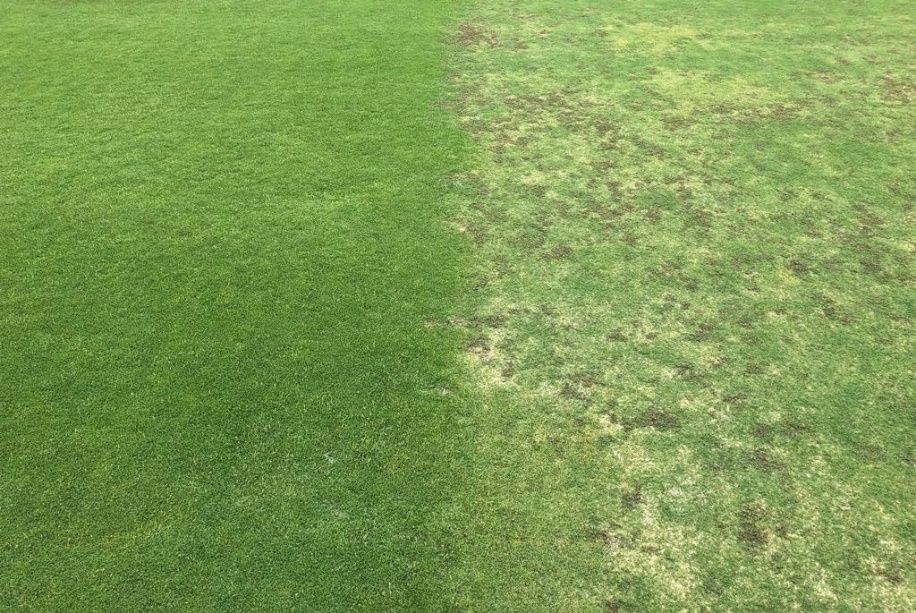
Credit: Pawel Petelewicz, UF/IFAS Department of Agronomy
For additional resources on the environmental requirements of individual turfgrass types consult the species-specific publications mentioned in Proper Management and Cultural Practices subsection of this document. For more information on how to prepare for a new lawn consult Preparing to Plant a Florida Lawn (https://edis.ifas.ufl.edu/LH012).
Pest Control
Pest damage makes the turf more susceptible to weed infestations by creating spaces for weed establishment and reducing the turf's competitive ability (Figure 10). Specifically, tunneling from mole crickets disrupts the soil surface, enabling weed seeds to readily germinate. Other insects and diseases can cause areas of turf to become bare. These open areas are usually slow to recover and enable weeds to become established and grow quickly. High nematode populations also thin the turf and make it less able to recuperate from environmental stresses. Weeds that often become established in nematode-infested soil include spotted spurge and Florida pusley.

Credit: Pawel Petelewicz, UF/IFAS Department of Agronomy
To prevent your lawn from other pests consult Turfgrass Disease Management (https://edis.ifas.ufl.edu/LH040), Homeowner’s Guide to Fungicides for Lawn and Landscape Disease Management (https://edis.ifas.ufl.edu/PP154), and Nematode Management in Residential Lawns (https://edis.ifas.ufl.edu/NG039).
Sanitation
It is extremely important to prevent the introduction of weeds into lawn areas. If one can prevent weed establishment, control practices are not necessary. Areas adjacent to turf areas that are hard to mow, such as fence rows or ditch banks, often support a weed population. These weeds normally produce seed that infests the nearby turf. These areas should also receive weed management attention. Another good practice is to wash off mowers and trimmers used in weed-infested areas before mowing or trimming in weed-free areas. Similarly, rototillers should be thoroughly cleaned prior to and after use to minimize weed seed dispersal in the soil. Yard clippings that contain weeds should be properly disposed of or composted to reduce the possibility of contamination. These sanitation practices are also important to prevent the introduction of other turfgrass species, which might reduce the purity and quality of the lawn. If construction or renovation is planned, it is important to use weed-free soil. When planting, use only certified seed or weed-free sod to minimize weed spread. It is not unreasonable to request a tour of the sod farm where the sod will be purchased in order to inspect grass quality.
Non-chemical Weed Control Methods
As previously stated, it is essential to properly maintain turf to minimize weed invasion. If weeds become established, several additional non-chemical methods of control are available.
Mowing
In addition to being an integral part of turfgrass management program, mowing can serve also as a direct weed control method. Many weeds cannot survive under close mowing conditions and can be eliminated if proper height-of-cut and frequency are maintained. As a rule of thumb, when mowing, remove only a third of the turf's leaf blade at a time. This maintains a turf canopy that can grow vigorously while shading weeds and suppressing their growth. Mowing prior to weed seedhead formation also reduces weed seed reserves. Some weeds, however, readily establish below the desired mowing height. Management of these weeds requires additional control methods. While it is generally recommended to mow without a basket to return nutrients with clippings back to turf, in situations when weeds are producing seedheads, mowing with a basket may reduce their expansion.
Hand-pulling or rogueing
Manual weed removal is the most environmentally friendly method for reducing weed infestations; thus, it is recommended whenever feasible. When hand-pulling weeds, it is critical to remove the roots and other underground parts to ensure the weeds will not survive and produce new shoots. Weeds such as Florida pusley and Virginia buttonweed might require the use of a small shovel to properly dig out the roots. If only a few weeds are present, it's simpler and less time-consuming to physically remove the plant, but if weeds are a major problem, other alternatives can be considered.
Smothering
Smothering with nonliving material to exclude light is effective in certain areas, such as flower beds, foot paths, or nurseries; however not where the turfgrass is grown. Materials used for this include mulch, leaves, rocks, and plastic film. To be effective, a minimum of 2 inches is required when using natural mulch materials. As an alternative, synthetic mats impregnated with herbicides can be used. These provide long-term weed control when properly used, but care must be taken to minimize the risk of desirable plant roots encountering these layers.
Chemical Weed Control Methods
Chemical weed control is achieved with herbicides. Herbicide is any chemical substance (of natural or synthetic origin) or cultured biological organism that is used to kill, injure, or suppress an undesired plant. Herbicides are safe and effective if product label instructions are followed. When deciding upon using this method, it is extremely important to follow all of such recommendations, restrictions, and precautions. Herbicide label constitutes the law. Label instructions include proper application timing, rates, and application methods. Moreover, labels contain information on how to handle product in a safe and responsible manner to protect self, others, and the environment. Herbicide application timing during the plant's growth cycle is important. Weeds are usually easier to control before they mature, i.e., start tillering and forming creating seedheads. If not controlled prior to seedhead formation, they are harder to control and are able to deposit new seeds in the future. Established perennial weeds may also be successfully targeted when their growth slows down following the vegetative stage in the season. Due to considerable diversity among herbicide options, there are multiple ways for classification to be established.
Herbicide Types
Turfgrass herbicides are most often categorized into groups based on application timing (i.e., preemergence and postemergence), site of application (i.e., soil and foliar applied), mobility within a plant (i.e., contact and systemic), target selectivity (i.e., selective and non-selective), and user group (professional-grade products and widely available consumer/homeowner-grade products).
Application timing-based classification:
Preemergence—Preemergence herbicides form the basis for a chemical weed control program in turfgrasses and are used primarily to control annual grasses (e.g., crabgrass, goosegrass, and annual bluegrass) and certain annual broadleaf weeds (e.g., common chickweed, chamberbitter, and lawn burweed). Preemergence herbicides are applied prior to weed seed germination. Knowledge of weed life cycles is important, especially when herbicide application is timed to attempt preemergence control. If the chemical is applied after plant emergence, preemergence herbicides have little or no effect. This narrow window of application timing is a potential disadvantage for many lawn care companies and homeowners, who often wait too late in the spring to apply the preemergence herbicide. A general rule of thumb for preemergence herbicide application is February 1 in south Florida, February 15 in central Florida, and March 1 in north Florida, or before day temperatures reach 65°F–70°F for 4 or 5 consecutive days. These application timings generally coincide with blooming of landscape plants, such as azalea and dogwood. If goosegrass is the primary weed species expected, wait 3–4 weeks later than these suggested application dates, because goosegrass germinates later than most summer annual grasses.
For preemergence control of winter annual weeds such as annual bluegrass, apply an herbicide when nighttime temperatures drop to 55°F–60°F for several consecutive days (early October for north Florida; late October to early November for central and south Florida). Irrigation before and after application is necessary to activate most preemergence herbicides. Preemergence herbicides are generally effective in controlling weeds from 6–12 weeks following application. Most herbicides begin to degrade soon after application when exposed to the environment. Therefore, to obtain season-long control, an additional application should follow 6–9 weeks after the initial one per label directions.
Note: On those areas where turf is to be established (including sod and winter overseeded areas), most preemergence herbicides should not be used 2–4 months before planting. Otherwise, root damage and germination reduction of the turf seed may result.
Postemergence—Postemergence herbicides are active on emerged weeds. Weed size is very important for proper herbicide action. Generally, the younger the weed seedling, the easier it is to control. If the herbicides are sprayed when the weeds are mature, high rates are required for achieving control, which increases the risk of turf injury. Postemergence herbicide effectiveness is reduced when the weed is under drought stress, cold stress, has begun to produce seeds, or is mowed before the chemical has time to work (several days after application). Avoid application when these growing conditions exist.
Some formulated pre-mixed products on the market may consist of both pre- and postemergence products.
Site of application-based classification:
Soil-applied—This group mainly encompasses preemergence herbicides; however, there are some postemergence options (e.g., metribuzin, simazine) that offer various levels of root-activity. In both cases, the herbicides need to reach the soil. Therefore, if they are retained on the foliage, either due to not watering them in with irrigation or rainfall, or due to too small of a droplet and/or water carrier volume used, they will exhibit reduced efficacy.
Foliar-applied—This group mainly consists of postemergence herbicides that require to be retained on the foliage to be effective. Contrary to soil-applied herbicides, if they are washed off the foliage too early, either with rain or irrigation, they will exhibit reduced efficacy.
Mobility within a plant-based classification:
Contact—Contact herbicides affect only the portion of green plant tissue contacted by the herbicide spray. Injury symptoms may appear rapidly—at times, a few hours after application, but the thorough coverage is critical for effectiveness. These herbicides, however, are not translocated or moved in plants' vascular systems. Therefore, they do not kill underground plant parts, such as rhizomes or tubers and tend to have limited ability to control perennial species. Repeat applications are often needed with contact herbicides to kill regrowth from these underground plant parts. If applied to non-target woody ornamentals, plants may have chances for recovery if not thoroughly covered. Examples of contact herbicides include bentazon (e.g., Basagran T&O), glufosinate (Finale XL T&O), and diquat (Reward).
Systemic—Systemic herbicides are translocated in the plant's vascular system. The vascular system transports the nutrients and water necessary for normal growth and development. Due to this, systemic herbicides generally are slower acting and kill plants over a period of days but have the capacity to control perennial species with extensive root systems or spreading via rhizomes and/or stolons. Secondly, thorough coverage is not as critical with systemic herbicides as it is with contact herbicides. While better control always will be achieved with thorough coverage, systemic herbicides may work on smaller weeds even if the weed is not thoroughly contacted by spray, thanks to already mentioned translocation. It is also important to note that for those same reasons, systemic herbicides are much less forgiving if the off-target plants are impacted—in some situations those plants may not recover. Examples of systemic herbicides include imazaquin (e.g., Scepter T&O 70 WDG), metsulfuron (e.g., Manor), sethoxydim (e.g., Segment II), and thiencarbazone + iodosulfuron + halosulfuron (e.g., Celsius XTRA).
Target selectivity-based classification:
Selective—A selective herbicide controls certain plant species (weeds) without seriously affecting the growth of other plant species (desired turfgrass). Most herbicides are selective herbicides. Herbicides are selected based on the turfgrass species. This simplifies the application because the herbicide can be applied over the turf without injuring it.
Nonselective—Nonselective herbicides control green plants regardless of species. They are generally used to kill all plants, such as in the renovation or establishment of a new turf area, as a spot treatment, or to trim along sidewalks. Glyphosate (e.g., Roundup), glufosinate (e.g., Finale XL T&O), and diquat (e.g., Reward) are examples of nonselective herbicides. These herbicides injure turf. Therefore, in an established turf, their use is usually limited to spot applications for weedy patches when selective alternatives are not available. Unless the damaged area is small and turfgrass can grow back in, such nonselective uses usually need to be followed by reestablishing turf in the treated area by reseeding or resodding.
Target user group-based classification:
Professional-grade products—This category of products is primarily intended for use by trained and/or certified professional personnel equipped with carefully calibrated application equipment to ensure precise control of the delivered product rate. It includes both restricted and non-restricted use products. In either case, users must adhere to label recommendations, restrictions, and precautions, and follow instructions regarding protective equipment and responsible handling to ensure the safety of themselves, others, and the environment. While homeowners/consumers may acquire possession of such products in some instances, their use without meeting the aforementioned conditions (i.e., precisely calibrated application equipment, personal protective equipment, safe storage, required training, certification, etc.) is not encouraged. For a comprehensive summary of professional-grade herbicides for use in turfgrass and information on proper resistant management practices consult the Turfgrass Herbicides: Mode of Action and Resistance Management (https://edis.ifas.ufl.edu/AG398).
Consumer/homeowner-grade products—Typically, only basic equipment like spreaders or portable pressure sprayers is required, with some products providing appropriate application devices. No licensing is required for their use, but users must comply with label recommendations, restrictions, and precautions, akin to professional-grade products. Additionally, safe and proper handling and storage of these products are advised. A summary of products from this category is provided at the end of this publication.
Fertilizer/Herbicide Mixtures
Some herbicides are formulated with a fertilizer as the carrier. Fertilizer/herbicide mixtures, so called weed’n’feed products enable a combined weed control and nutrient treatment in the same application to the turfgrass. These materials should only be used when a lawn has a uniform weed population, which is a rare occurrence, or when the herbicide component is supposed to provide preemergence control. In the latter case however, those products usually have weed stop or prevent phrases in their names. If weeds exist only on a portion of the lawn, it is unjustified to apply a weed’n’feed product to the entire lawn. If the situation warrants the use of a weed’n’feed product, it is important to determine if the manufacturer's recommended application rate supplies the amount of fertilizer needed by the turfgrass and the amount of herbicide required for weed control. Supplemental applications of fertilizer or herbicide may be required if the fertilizer/herbicide product does not supply enough fertilizer or herbicide to meet the fertility needs of the turfgrass or the amount of herbicide needed for weed control. Also, the weed’n’feed products should be avoided in north Florida for control of summer annual weeds for the first application. The timing of the preemergence herbicide (March 1) does not coincide with the recommended timing for the first fertilizer application of the season (April 15). Turfgrass fertilizer/herbicide products should be used with caution near ornamentals. Products containing dicamba, metsulfuron, or atrazine can be absorbed by the roots of ornamentals and cause severe injury. Do not apply products that contain these chemicals over the root zone of ornamental trees and shrubs.
Adjuvants
An adjuvant is a spray additive that enhances the performance or handling characteristic of an herbicide. Adjuvants include surfactants, crop oils, and crop oil concentrates, which if used indiscriminately may result in severe turfgrass injury or decreased herbicide performance. These additives do not improve the performance of preemergence herbicides and are used only with postemergence herbicides absorbed through the leaf. The herbicide label will indicate whether a spray additive is required.
Weed Control Prior to Turf Establishment
A nonselective herbicide should be used to kill existing weeds such as contaminant bermudagrass or nutsedge, which must be eradicated prior to grass establishment. These nonselective herbicides control only emerged plants. The selective postemergence options may be tank-mixed as allowed by individual product labels to enhance control of challenging species such as bermudagrass. For best results, apply two or three treatments of a nonselective herbicide 14 days apart.
Seeded Areas
Do not apply preemergence herbicides prior to or immediately following seeding of grasses such as common bermudagrass, bahiagrass, centipedegrass, or ryegrass (winter overseed). Because of their root-pruning or seedling-kill modes of action, preemergence herbicides may be applied only after seeded grasses have emerged and are well established. A rule of thumb for timing is to make an application after the desired grasses are 2–3 inches tall or have begun to spread by runners (stolons). At this time, the preemergence herbicide may be applied at half the normal rate of application. Postemergence herbicides may also be applied at half the rate at the same growth stage. If a preemergence herbicide has been applied, wait 9 weeks before attempting seeding. Use a small test area to determine when the herbicide residues permit seedling growth.
Sprigged, Sodded, or Plugged Areas
After planting, preemergence herbicides may be applied at half the normal rate recommended for established grasses following signs of new growth. Water should be applied immediately to the treated areas to activate the herbicide. If herbicide is not applied soon after planting, weed seedlings will emerge and will not be affected by preemergence herbicides. If over half the recommended herbicide rate is applied, root pruning may result to the turf. Postemergence herbicides, in general, should not be applied until the grass is visibly growing and spreading. Mowing helps control most broadleaf weeds until the lawn is well established. Spot spraying of weeds should be practiced until establishment occurs.
Weed Control in Established Turf
Preemergence Weed Control
In established turfgrass, members of the dinitroaniline herbicide family like pendimethalin (e.g., Scotts WeedEx Prevent with Halts) or prodiamine (e.g., in Bonide ProZone Weed Beater Complete, Bonide Sedge Ender) control annual grass and some broadleaf weed species when applied prior to weed seed germination. Herbicides like dithiopyr (e.g., Preen Lawn Crabgrass Control, in Spectracide Weed Stop For Lawns Plus Crabgrass Preventer Granules) also provide preemergence annual grass and broadleaf control. Atrazine (e.g., Spectracide Weed Stop For Lawns For St. Augustine & Centipede Lawns) and isoxaben (e.g., in BioAdvanced Season Long Weed Control For Lawns) primarily provide preemergence control of broadleaf weeds. To create a preventive layer in the soil, all these herbicides must be activated with irrigation or moderate rain within 2 days after application so they will be in direct contact with the germinating seeds and emerging weed seedlings. If the soil is dry, their weed-killing effect is greatly limited. On the other hand, if the turf is overirrigated, most preemergence herbicides will be moved below the soil layer where the germinating weed seeds are, reducing weed control.
Postemergence Weed Control
Broadleaf weed control—Broadleaf weeds in turf have traditionally been controlled with auxinic herbicides such as 2,4-D, MCPP, and dicamba. All are selective, systemic, foliar-applied herbicides; few broadleaf weeds, especially perennials, are controlled with just one of these materials. Therefore, these materials are commonly found in three-way and four-way herbicide mixtures, such as Ortho Weed B-gon Weed Killer for St. Augustinegrass, BioAdvanced Southern Weed Killer For Lawns, and many others. Products containing atrazine (e.g., Spectracide Weed Stop For Lawns For St. Augustine & Centipede Lawns), penoxsulam (e.g., in Image Southern Lawn Weed Killer for St. Augustinegrass and Centipedegrass), carfentrazone [Ortho WeedClear™ Lawn Weed Killer (South)], sulfentrazone (in Spectracide Weed Stop For Lawns), or imazaquin (Image Kills Nutsedge) can also provide effective control of broadleaf weeds. Additionally, repeat applications on time interval described on the product label are usually necessary for satisfactory weed control with any of the herbicides mentioned above.
Grass weed control—Postemergence control of grassy weeds is a major challenge because few products selective to the turf also kill this type of weed. For this reason, preventive management and preemergence control are key for successful management of grassy weeds. When needed, atrazine-containing materials (e.g., Spectracide Weed Stop For Lawns For St. Augustine & Centipede Lawns) can help control young grassy weeds with the added benefit of controlling many young broadleaf weeds in St. Augustinegrass and centipedegrass. Otherwise, only a few professional-grade alternatives can be used when postemergence control is necessary.
Nutsedge control—Yellow and purple nutsedge (often inappropriately called nut-grass) are the predominant nutsedge weed species in turfgrass. Other examples include globe or annual sedge, perennial and annual kyllinga, Texas sedge, flathead sedge, and cylindrical sedge. Path or slender rush, a member of the rush family, also can occur in some turf situations. These weeds generally thrive in soils that remain wet for extended periods of time because of poor drainage or excessive irrigation. The first step in nutsedge control is to correct the cause of continuously wet sites. Do not overirrigate an area and, if necessary, provide surface and subsurface drainage. Selective control of various sedges is available with herbicides such as imazaquin (Image Kills Nutsedge), penoxsulam (e.g., in Image Southern Lawn Weed Killer for St. Augustinegrass and Centipedegrass), or sulfentrazone (e.g., Ortho Nutsedge Killer For Lawns). Even with good herbicide coverage, regrowth normally occurs from the roots and tubers, and repeat applications are necessary. In case of nutsedges, possibly several years will be required to control all the underground reproductive parts.
Application Procedures
Proper rates—To avoid injury (e.g., yellowing, browning, stunting) to turfgrasses and ornamentals, apply the proper rate of herbicide. Mark off 1,000-square-foot areas to apply herbicides. Apply herbicides in ½–1 gallon of water per 1,000 square feet (approximately 20–40 gallons per acre).
Applicators—For increased application accuracy, air-pressure-type sprayers are preferred over hose-end-type sprayers. For herbicides formulated as granules, use a spreader and calibrate properly.
Vapor drift—Volatile vapor drift from 2,4-D esters or spray drift from 2,4-D amines, dicamba, or other phenoxy or benzoic acid compounds may damage sensitive plants such as ornamentals, trees, vegetables, or fruits. Amine forms of phenoxy herbicides can be used with greater safety near sensitive plants, but caution should still be exercised.
Equipment—Do not apply insecticides, fungicides, or other herbicides with equipment used for 2,4-D because it is difficult to remove this herbicide from most sprayers.
General Pesticide Information
Labels—Observe all directions, restrictions, and precautions on pesticide labels. It is dangerous, wasteful, and illegal to do otherwise. Pay special attention to the restricted-entry interval (REI) information. Home lawns have high traffic of children and pets, so it is important to make sure they do not enter the treated area during the REI. For some herbicides, the label specifies that the herbicide is intended for use only by trained and licensed personnel using specialized equipment. If you cannot meet such requirements, do not use the product.
Storage—Store pesticides behind locked doors in original containers with label intact, separate from seed and fertilizer.
Dosage—Use pesticides at correct dosage and intervals between applications to avoid illegal residues or injury to plants and animals.
Rinsing—Triple rinse a container that has been emptied into the spray tank. Never pour pesticides down a drain or into an area where humans, animals, or water could be exposed.
Disposal—Dispose of used containers in compliance with label directions to avoid water contamination and other hazards.
Clothing—Always wear protective clothing as required by the product label when applying pesticides. At a minimum, wear a long-sleeved shirt, long-legged pants, rubber gloves, chemically resistant boots, eye protection, and a wide-brimmed hat. Never go barefoot or wear sandals. Additional protective gear may be listed on the pesticide label.
Handling—Never eat, drink, or use tobacco products when handling pesticides, and always wash with soap and water after use.
Additional Resources
For additional information and guidance on proper management practices and control strategies for weeds in landscape consult the Improving Weed Control in Landscape Planting Beds (https://edis.ifas.ufl.edu/EP523), Florida Homeowner Herbicide Guide (https://edis.ifas.ufl.edu/EP575), and/or Postemergence Herbicides for Use in Ornamentals (https://edis.ifas.ufl.edu/publication/WG059).
Table 1. Herbicide options available for homeowners (i.e., non-restricted use) for the selective control or suppression of weeds in most prevalent Florida turfgrasses.